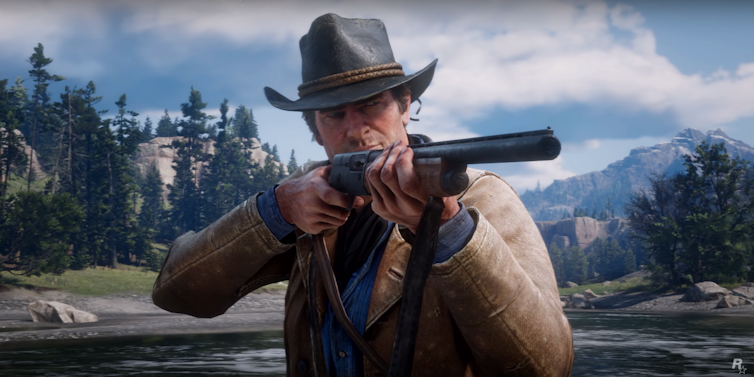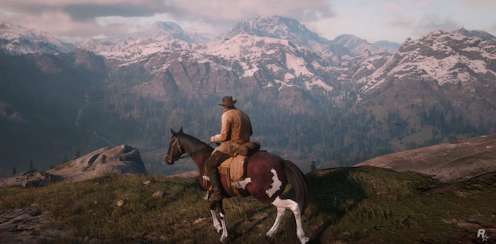Red Dead Redemption 2, a new video game about an outlaw gang on the American frontier in 1899, has been met with huge adoration. Journalists have lauded it as a “landmark” title, a “technological masterpiece”, even a “watershed moment” in entertainment. Much of the praise has focused on how developer Rockstar Games has coded a “living” game world that oozes character and aesthetic richness.
However, now that the digital dust has started to settle, that same world has come in for criticism. Gamers have dubbed the title “boring” and “slow,” with their enjoyment of the game noticeably impeded by “clunky controls” and the lack of easy “fast travel” between destinations. Matt Reynolds for Wired recently complained how Red Dead Redemption 2 ultimately “feels like a chore.” The ability to kill a life-like female suffragette in the game also courted controversy, with YouTube first banning then restricting the gratuitous footage.
The price of realism
Most of the criticism reflects a growing problem with video games: the pursuit of realism. For decades now, mainstream developers (with the notable exception of Nintendo) have committed their energies to crafting visually realistic game worlds. More than any other studio, Rockstar has dedicated itself to the holy digital grail of verisimilitude, throwing millions of dollars (and controversially long work hours for its staff) chasing reality.
In the 1970s, arcade Westerns such as Midway’s Gun Fight featured barely-animated stick figures “firing” dots at each other across a landscape populated by a single pixelated cactus. By contrast, in Red Dead Redemption 2, game character Arthur Morgan’s hair, wardrobe and waistline grows and stunning digital vistas rival Albert Bierstadt’s paintings of the 1800’s American Interior.
In Rockstar’s stunning quest for the life-like, more than 170 species of animal wander the digital terrain. In the 1870s, Eadweard Muybridge, seeking to answer the question of how horses gallop, captured their movement through a series of photographs. Nearly 150 years on, Rockstar uses 21st-century motion capture to perfect literally hundreds of “living”, “breathing”, and galloping horses on the digital screen, to such detail that, as lad magazines recently enthused, even their testicles shrink in the cold.

Too much responsibility?
Not only has Rockstar strived for visual realism, but the studio has constructed a world of realistic player activities and responsibilities. From their inception, video games have digitised the “every day”. From delivering newspapers in Atari’s Paperboy (1984) to collecting airport baggage in Apollo’s Lost Luggage (1982), video games have transformed mundane tasks into moments of digital revelry. Released back in the 1990s, Sega’s Shenmue (1999), set in a “living” Japanese city, incorporated a range of daily tasks including driving a forklift for money. Such titles have provided moments of “playful realism”.
Red Dead Redemption 2 represents a new scale-up and seriousness to the enterprise. As the character Arthur Morgan, the player is expected to hunt and skin wild animals, maintain his guns and wares fastidiously, and feed and groom his horse. In the process, Red Dead Redemption 2 undoubtedly offers a more meaningful adventure. But the game also tests boundaries over notions of play and digital experience.
Unfortunately, performing work-like tasks and living the “every day” in games can easily test our patience. The closer a game gets to any semblance of reality, the greater the player notices its flaws. In “reality”, most of us (at least on a basic level) can choose when to do things, perform tasks freely and organically, and process multiple sensations while doing them (such as the weight of an item, or our own limited strength).
In ultra-realistic games, those expectations are quickly frustrated: we push a complex sequence of buttons to perform simple actions (such as drawing a gun), we lose authorial control (and voice) to orchestrated story arcs (Red Dead’s set missions), and narrow visual cues become an excuse for human experience. In-game realism is quite a different property, then, to the world outside.
Too much realism also rails against the basic appeal of games: to escape, to play, to indulge in fantasy (in other words, the “unreal”) and most of all, have fun.
Writing in Homo Ludens (1938) on the concept of games, Johan Huizinga declared “the fun-element” crucial to “the essence of play”. In the case of Red Dead Redemption 2, Rockstar has pushed the boundaries of gamic realism to new heights of maturity and sophistication. Rockstar shows how we can find beauty in a digital place and a digital moment, and is actively testing what “gameplay” means. However, while a landmark title, few reviewers have applauded the game as enjoyable. The true limit of gamic realism may not come in terms of technological hardware, programmer hours or dollars spent, but in our basic human desire for games to be fun.


